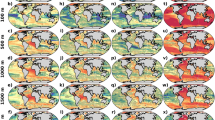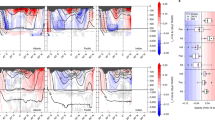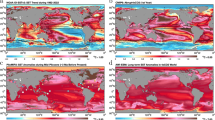Abstract
The attribution of anthropogenically forced trends in the climate system requires an understanding of when and how such signals emerge from natural variability. We applied time-of-emergence diagnostics to a large ensemble of an Earth system model, which provides both a conceptual framework for interpreting the detectability of anthropogenic impacts in the ocean carbon cycle and observational sampling strategies required to achieve detection. We found emergence timescales that ranged from less than a decade to more than a century, a consequence of the time lag between the chemical and radiative impacts of rising atmospheric CO2 on the ocean. Processes sensitive to carbonate chemical changes emerge rapidly, such as the impacts of acidification on the calcium carbonate pump (10 years for the globally integrated signal and 9–18 years for regionally integrated signals) and the invasion flux of anthropogenic CO2 into the ocean (14 years globally and 13–26 years regionally). Processes sensitive to the ocean’s physical state, such as the soft-tissue pump, which depends on nutrients supplied through circulation, emerge decades later (23 years globally and 27–85 years regionally).
This is a preview of subscription content, access via your institution
Access options
Access Nature and 54 other Nature Portfolio journals
Get Nature+, our best-value online-access subscription
$29.99 / 30 days
cancel any time
Subscribe to this journal
Receive 12 print issues and online access
$209.00 per year
only $17.42 per issue
Buy this article
- Purchase on Springer Link
- Instant access to full article PDF
Prices may be subject to local taxes which are calculated during checkout






Similar content being viewed by others
Data availability
The GFDL LE data that support the findings of this study are publicly available through Globus (http://poseidon.princeton.edu).
References
Sarmiento, J. L., Hughes, T. M. C., Stouffer, R. J. & Manabe, S. Simulated response of the ocean carbon cycle to anthropogenic climate warming. Nature 393, 245–249 (1998).
Volk, T. & Hoffert, M. I. in The Carbon Cycle and Atmospheric CO 2 : Natural Variations Archean to Present Geophysical Monograph 32 (eds Sundquist, E. T. & Broecker, W. S.) 99–110 (American Geophysical Union, 1985).
Riebesell, U., Kortzinger, A. & Oschlies, A. Sensitivities of marine carbon fluxes to ocean change. Proc. Natl Acad. Sci. USA 106, 20602–20609 (2009).
Gruber, N. et al. in The Global Carbon Cycle (eds Gruber, N. et al) 45–76 (Island, 2004).
Doney, S. C. et al. Climate change impacts on marine ecosystems. Ann. Rev. Mar. Sci. 4, 11–37 (2011).
Moore, J. K. et al. Sustained climate warming drives declining marine biological productivity. Science 359, 1139–1143 (2018).
Arora, V. K. et al. Carbon–concentration and carbon–climate feedbacks in CMIP5 Earth system models. J. Clim. 26, 5289–5314 (2013).
Broecker, W. S. & Peng, T.-H. Tracers in the Sea (Lamont-Doherty Geological Observatory, 1982).
Battaglia, G., Steinacher, M. & Joos, F. A probabilistic assessment of calcium carbonate export and dissolution in the modern ocean. Biogeosciences 13, 2823–2848 (2016).
Berelson, W. M. et al. Relating estimates of CaCO3 production, export, and dissolution in the water column to measurements of CaCO3 rain into sedimenttraps and dissolution on the sea floor: a revised global carbonate budget. Glob. Biogeochem. Cycles 21, GB1024 (2007).
Sarmiento, J. L. et al. A new estimate of the CaCO3 to organic carbon export ratio. Glob. Biogeochem. Cycles 16, 1107 (2002).
Dunne, J. P., Armstrong, R. A., Gnanadesikan, A. & Sarmiento, J. L. Empirical and mechanistic models for the particle export ratio. Glob. Biogeochem. Cycles 19, GB4026 (2005).
Henson, S. A. et al. A reduced estimate of the strength of the ocean’s biological carbon pump. Geophys. Res. Lett. 38, L04606 (2011).
Siegel, D. A. et al. Global assessment of ocean carbon export by combining satellite observations and food-web models. Glob. Biogeochem. Cycles 28, 181–196 (2014).
Rödenbeck, C. et al. Data-based estimates of the ocean carbon sink variability—first results of the Surface Ocean \(p_{{\rm{CO}}_2}\); Mapping intercomparison (SOCOM). Biogeosciences 12, 7251–7278 (2015).
Jones, C. et al. Twenty-first-century compatible CO2 emissions and airborne fraction simulated by CMIP5 Earth system models under four representative concentration pathways. J. Clim. 26, 4398–4413 (2013).
Lovenduski, N. S., McKinley, G. A., Fay, A. R., Lindsay, K. & Long, M. C. Partitioning uncertainty in ocean carbon uptake projections: internal variability, emission scenario, and model structure. Glob. Biogeochem. Cycles 30, 1276–1287 (2016).
Laufkötter, C. et al. Projected decreases in future marine export production: the role of the carbon flux through the upper ocean ecosystem. Biogeosciences 13, 4023–4047 (2016).
McKinley, G. A. et al. Timescales for detection of trends in the ocean carbon sink. Nature 530, 469–472 (2016).
Li, H. & Ilyina, T. Current and future decadal trends in the oceanic carbon uptake are dominated by internal variability. Geophys. Res. Lett. 45, 916–925 (2018).
Frölicher, T. L., Joos, F., Plattner, G.-K., Steinacher, M. & Doney, S. C. Natural variability and anthropogenic trends in oceanic oxygen in a coupled carbon cycle-climate model ensemble. Glob. Biogeochem. Cycles 23, GB1003 (2009).
Christian, J. R. Timing of the departure of ocean biogeochemical cycles from the preindustrial state. PLoS ONE 9, e109820 (2014).
Rodgers, K. B., Lin, J. & Frölicher, T. L. Emergence of multiple ocean ecosystem drivers in a large ensemble suite with an Earth system model. Biogeosciences 12, 3301–3320 (2015).
Long, M. C., Deutsch, C. & Ito, T. Finding forced trends in oceanic oxygen. Glob. Biogeochem. Cycles 30, 381–397 (2016).
Keller, K. M., Joos, F. & Raible, C. C. Time of emergence of trends in ocean biogeochemistry. Biogeosciences 11, 3647–3659 (2014).
Henson, S. A. et al. Detection of anthropogenic climate change in satellite records of ocean chlorophyll and productivity. Biogeosciences 7, 621–640 (2010).
Frölicher, T. L., Rodgers, K. B., Stock, C. A. & Cheung, W. W. L. Sources of uncertainties in 21st century projections of potential ocean ecosystem stressors. Glob. Biogeochem. Cycles 30, 1224–1243 (2016).
Carter, B. R. et al. When can ocean acidification impacts be detected from decadal alkalinity measurements? Glob. Biogeochem. Cycles 30, 595–612 (2016).
Dunne, J. P. et al. GFDL’s ESM2 global coupled climate–carbon Earth system models. Part I: Physical formulation and baseline simulation characteristics. J. Clim. 25, 6646–6665 (2012).
Dunne, J. P. et al. GFDL’s ESM2 global coupled climate–carbon Earth system models. Part II: Carbon system formulation and baseline simulation characteristics. J. Clim. 26, 2247–2267 (2013).
Woods, J. D. The World Ocean Circulation Experiment. Nature 314, 501–511 (1985).
Gleckler, P. J. et al. Human-induced global ocean warming on multidecadal timescales. Nat. Clim. Change 2, 524–529 (2012).
Manabe, S., Bryan, K. & Spelman, M. J. Transient response of a global ocean–atmosphere model to a doubling of atmospheric carbon dioxide. J. Phys. Oceanogr. 20, 722–749 (1990).
Séférian, R., Bopp, L., Swingedouw, D. & Servonnat, J. Dynamical and biogeochemical control on the decadal variability of ocean carbon fluxes. Earth Syst. Dyn. 4, 109–127 (2013).
Andrews, O. D., Bindoff, N. L., Halloran, P. R., Ilyina, T. & Le Quéré, C. Detecting an external influence on recent changes in oceanic oxygen using an optimal fingerprinting method. Biogeosciences 10, 1799–1813 (2013).
Sarmiento, J. L. & Gruber, N. Ocean Biogeochemical Dynamics (Princeton Univ. Press, 2006).
Fassbender, A. J., Rodgers, K. B., Palevsky, H. I. & Sabine, C. L. Seasonal asymmetry in the evolution of surface ocean \(p_{{\rm{CO}}_2}\) and pH thermodynamic drivers and the influence on sea–air CO2 flux.Glob. Biogeochem. Cycles 32, 1476–1497 (2018).
Gallego, M. A., Timmermann, A., Friedrich, T. & Zeebe, R. E. Drivers of future seasonal cycle changes of oceanic pco 2. Biogeosci. Discuss. 15, 5315–5327 (2018).
Takahashi, T. et al. Climatological mean and decadal change in surface ocean pco2, and net sea-air CO2 flux over the global oceans. Deep Sea Res Pt II 56, 554–577 (2009).
Rodgers, K. B. et al. A wintertime uptake window for anthropogenic CO2 in the North Pacific. Glob. Biogeochem. Cycles 22, GB2020 (2008).
Landschützer, P., Gruber, N., Bakker, D. C. E., Stemmler, I. & Six, K. D. Strengthening seasonal marine CO2 variations due to increasing atmospheric CO2. Nat. Clim. Change 8, 146–150 (2018).
Siegel, D. A. et al. Prediction of the export and fate of global ocean net primary production: the EXPORTS science plan. Front. Mar. Sci. 3, 4–10 (2016).
Johnson, K. & Claustre, H. Bringing biogeochemistry into the Argo Age. Eos 97, https://doi.org/10.1029/2016EO062427 (2016).
Hostetler, C. A., Behrenfeld, M. J., Hu, Y., Hair, J. W. & Schulien, J. A. Spaceborne lidar in the study of marine systems. Ann. Rev. Mar. Sci. 10, 121–147 (2018).
Meinshausen, M. et al. The RCP greenhouse gas concentrations and their extensions from 1765 to 2300. Climatic Change 109, 213–241 (2011).
McGregor, S. et al. Recent Walker circulation strengthening and Pacific cooling amplified by Atlantic warming. Nat. Clim. Change 4, 888–892 (2014).
England, M. H. et al. Recent intensification of wind-driven circulation in the Pacific and the ongoing warming hiatus. Nat. Clim. Change 4, 222–227 (2014).
Penduff, T. et al. Sea level expression of intrinsic and forced ocean variabilities at interannual time scales. J. Clim. 24, 5652–5670 (2011).
Majkut, J. D. et al. An observing system simulation for Southern Ocean carbon dioxide uptake. Phil. Trans. R. Soc. A 372, 20130046 (2014).
Christian, J. R., Feely, R. A., Ishii, M., Murtugudde, R. & Wang, X. Testing an ocean carbon model with observed sea surface pco2 and dissolved inorganic carbon in the tropical Pacific Ocean. J. Geophys. Res. 113, C07047 (2008).
Friedlingstein, P. et al. Uncertainties in CMIP5 climate projections due to carbon cycle feedbacks. J. Clim. 27, 511–526 (2014).
Frölicher, T. L. et al. Dominance of the Southern Ocean in anthropogenic carbon and heat uptake in CMIP5 models. J. Clim. 28, 862–886 (2015).
Bopp, L. et al. Multiple stressors of ocean ecosystems in the 21st century: projections with CMIP5 models. Biogeosciences 10, 6225–6245 (2013).
Acknowledgements
This work was supported by NASA award no. NNX17AI75G. Support for K.B.R. was provided by the Institute for Basic Science project code IBS-R028-D1, with additional support through NOAA award nos NA17RJ2612 and NA08OAR4320752, including support through the NOAA Office for Climate Observations and NOAA award no. NA11OAR4310066. T.L.F. acknowledges support from the Swiss National Science Foundation under grant no. PP00P2_170687. The numerical simulations were performed with the computational resources of NOAA/GFDL.
Author information
Authors and Affiliations
Contributions
S.S. performed all the analysis and writing, with regular feedback from K.B.R., J.L.S, T.L.F., J.P.D., M.I. and R.S. The LE simulations were set up by K.B.R. and T.L.F. and performed and postprocessed by K.B.R. The sensitivity experiments and control runs were performed by R.S.
Corresponding author
Ethics declarations
Competing interests
The authors declare no competing interests.
Additional information
Publisher’s note: Springer Nature remains neutral with regard to jurisdictional claims in published maps and institutional affiliations.
Supplementary information
Supplementary Information
Supplementary Notes 1–3, references and Figs. 1–7.
Rights and permissions
About this article
Cite this article
Schlunegger, S., Rodgers, K.B., Sarmiento, J.L. et al. Emergence of anthropogenic signals in the ocean carbon cycle. Nat. Clim. Chang. 9, 719–725 (2019). https://doi.org/10.1038/s41558-019-0553-2
Received:
Accepted:
Published:
Issue Date:
DOI: https://doi.org/10.1038/s41558-019-0553-2
This article is cited by
-
Early detection of anthropogenic climate change signals in the ocean interior
Scientific Reports (2023)
-
Trophic level decoupling drives future changes in phytoplankton bloom phenology
Nature Climate Change (2022)
-
Regional sensitivity patterns of Arctic Ocean acidification revealed with machine learning
Communications Earth & Environment (2022)
-
Projected reversal of oceanic stable carbon isotope ratio depth gradient with continued anthropogenic carbon emissions
Communications Earth & Environment (2022)
-
Impact of intensifying nitrogen limitation on ocean net primary production is fingerprinted by nitrogen isotopes
Nature Communications (2021)



